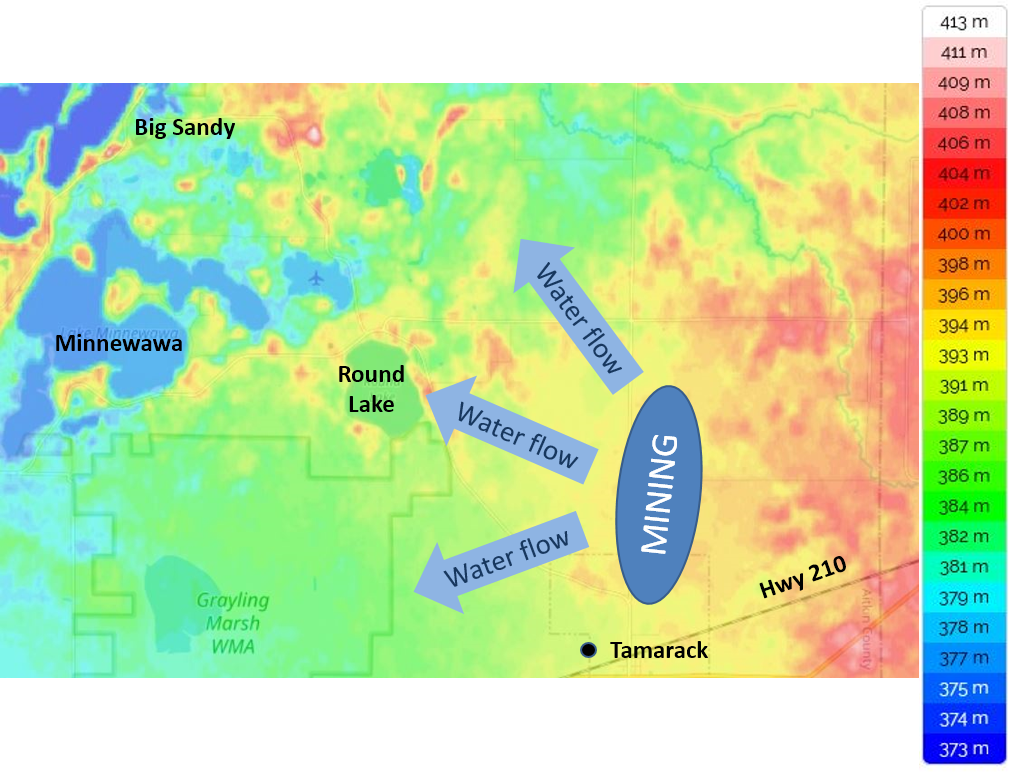Water Quality and Management
Talon Metals corporation plans to build a high sulfide nickel-copper mine in the Tamarack, MN area in coming years. These minerals are bonded to sulfur, forming sulfide minerals and are mined as sulfide ores. When these ores are exposed to air and moisture, a chemical reaction occurs that generates sulfuric acid that migrates into the surrounding environment and, through leaching, releases heavy metals present in the waste rock, pit walls, and tailings basins of mining operations. The sulfuric acid along with dissolved heavy metals released onto the land will seep into the rich aquifers below and then into streams and lakes at levels that are toxic to fish and other aquatic life. This type of pollution is commonly referred to as Acid Mine Drainage (AMD) and has the potential to devastate entire ecosystems. The close proximity of sulfide mines to valued water bodies such as lakes and rivers of the Mississippi watershed intensifies the magnitude of this issue. All of the water bodies in the Tamarack area are linked by multiple aquifers.
Talon Metals corporation proposed Tamarack mine will be located on high ground with surrounding lakes and rivers downstream
of the surface water runoff.
For example, the topographic map below shows how surface water from the mine will flow down toward Lake Minnewawa, Big Sandy Lake, Round Lake, Horseshoe Lake,
the Rice Lake Wildlife refuge, the Mississippi river and many other bodies of water.

When sulfide ores are exposed to air and moisture, a chemical reaction occurs that generates sulfuric acid. Thus, untreated water flowing from the mine facilities will likely be laden with sulfuric acid generating sulfide minerals and other dissolved toxic heavy metals.
Tamarack is a very wet area receiving about 30 inches of precipitation per year. Water from local aquifers will seep into any underground cavity. As such, Talon expects large amounts of water must be pumped to the surface, treated to remove contaminants and somehow disposed of. Page 228 of the Talon Preliminary Economic Analysis (PEA) indicates that the average instantaneous pumping requirements during steady state-mining are between 320 and 370 m3/h with peak flows greater than 400 m3/h or nearly 2.6 million gallons a day. Where does all this water go? How much will lake and well levels drop?
Although Talon has indicated that they might use large industrial Reverse Osmosis water filters to clean contaminated water, sizing these filters properly is an unknown factor. Talon's esitmate for how much water must be pumped is based on data from a few wells drilled prior to 2020. They do not take into account multiple daily blasts events which will surely open in cracks and fissures increasing the water flow. They do not take into account increased water flows due to the large caverns (stopes) created by the extraction of ore. Filling these areas may help but they are not filling with water proof materials. Thus the water flow is likely to much higher than Talon anticipates and what will they do with the water that they cannot clean? They will of course dump contaminated water into environment. Additionally, they can only clean what they collect and there are plenty of opportunities for contaminated water to be released into the environment.
- Where does Talon put the millions of gallons of water pumped out of the mine?
- What is the impact of pumping millions of gallons of freshwater on the surrounding area and aquifers? How much will lake levels, wetlands and well water levels drop?
- What’s the impact on the aquifers you cut through potentially mixing water between aquifers?
- Sulfide mines often have elevated levels of arsenic, mercury, and lead in wastes and wastewater – will that be monitored?